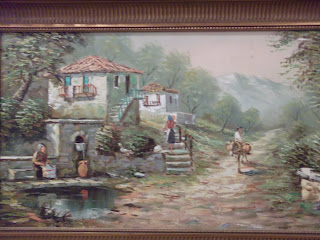
We are all consumers of culture. However our interpretation, reception and experience of various types of culture vary according to several factors, mainly differences that are socially constructed. These “socially constructed” differences create social classes, and reinforce the boundaries among them. No cultural object or practice is inherently sophisticated or “high brow” and similarly neither is essentially “low brow” or common. Instead, cultural tastes, standards, practices and experiences of those in the “upper class” become the society’s highbrow culture. For example, the fine arts consumed by the affluent classes, becomes the elite, sophisticated “highbrow” cultural practices that are distinguished from or “higher” than those practices of the lower and working class such as a variety of music genres like rap and hip hop, sports and recreational events like camping, boating etc.

source
Opera, fine arts, classical music, fine dining, symphonies, playing golf, collecting priceless antiques and abstract art and reading books for pleasure, are all linked to the upper class, highbrow culture.
On the other hand, fast food, gossip magazines, pop music, hip hop, sports such as baseball and basketball and other cultural products that have “mass appeal” are usually considered lowbrow.
These change over time. The boundaries between them blur, and the variation in consumption of culture from these two categories becomes more prevalent. Many families and homes today exude a wide variety of cultural consumption ranging from the elite highbrow symphonies to the rap tunes on their ipods. From decorating with abstract art and antiques in their homes, to ordering fast food take out and eating in front of the TV as opposed to eating at a fine dining restaurant or a neat dining table setting at home.

We are exposed to a wide variety of culture, and nowadays, belonging to a certain “class” does not necessarily dictate exactly what kind of music you listen to or what other cultural products you may consume. Although belonging to the upper social class may result in an inherent cultural capital, it does not limit your knowledge of other lowbrow popular culture or even the practice of it. You can listen to a wide variety of music, watch a variety of films, go to a variety of events, participate in different sports, and collect various kinds of art. The tolerance for a wider variety of cultural products is increasing and hence the number of cultural omnivores that experience and practice wider forms of culture, is rising. It is seldom that I come across someone who has just classical music on their mp3 players, or one genre of films in their DVD collection, or who just likes football, or only plays chess, or only goes to symphonies and watches classical Shakespeare plays in elaborate theatres. People belonging to the upper class are likely to engage in activities affiliated with the lower class and vice-versa.

I can see my own "cultural omnivoreness" in my consumption and practice of culture at home and outside. My sister and I play classical Tchaikovsky and Beethoven tunes on the piano, and also play popular music like soundtracks of movies like Pirates of the Caribbean and Harry Potter. My home is decorated with antiques and classical paintings and collections of historic pieces, “fine” china, and crystal.




Last summer, I attended a music concert for one of the most popular Lebanese singers in Lebanon, in my hometown in the mountains, Ehden. The artist's name is Najwa Karam, winner of over thirty music awards.
Today her music not only appeals to Lebanese people but Arab listeners worldwide listeners. Although Najwa Karam’s first album started with just Lebanese traditional/folkloric songs, her artistic identity and music albums then developed to include more romantic and contemporary themes and beats, appealing to a broader “modern” audience. Her latest albums fused Lebanese tradition with Arab pop. Although most of her albums to date are classic in style, Najwa’s music appeals to a wide range of Arab listeners and classes. This was evident in the concert I attended. People from all parts of Lebanon, and across the world especially diasporas travelled all the way to Ehden in the mountains to attend this concert.

There were people from all social classes, and backgrounds, elite to working lower class, different seating for different classes, and people from all parts of Lebanon travelled all the way to Ehden in the mountains to attend this concert. But still as soon as Najwa started singing there wasn’t a sense of segregation of the classes but a huge mix of cheering fans, who ultimately all like the same music. I am not a great fan of traditional Lebanese music, but a fan of Najwa Karam’s music, I don’t listen to all traditional Lebanese mucis, but only to hers, and her music is just another color in the rainbow of genres and styles of music in my song library. Her fusion of classic with contemporary Arab pop, can be a reason for its popularity among a wide range of listeners high and lowbrow consumers, which makes the artist herself, first a cultural omnivore, a consumer, interpreter and receiver of high (classic music) and lowbrow (pop music) culture.

Furthermore, I also take part in cultural events like the Palestinian Night in Education City, dressed in the traditional Palestinian abaya, and attend “highbrow” plays like the Sound of Music and symphonies in Queen Elizabeth Theatre in Toronto where I would be dressed differently, as the setting suggests. Lowbrow Palestinian night filled with cultural folk dances, traditional food, informal atmosphere, and charity sales is a big contrast to the “Queen Elizabeth” theatre’s theme, ambience and “class”. My far-ranging tastes and consumption of art and music, suggests I am indeed a cultural omnivore like many I know and interact with.

So what is the effect of cultural omnivores? How does this manifest in the hierarchy of cultural consumption? If all music and all art forms become digestible by almost everyone, what’s the point of classifying them? If the boundaries are to be obscured, and classes blurred, does this mean it will become more challenging to identify and sustain class boundaries if everyone’s cultural consumption no longer reflects certain standards, tastes or practices?
No comments:
Post a Comment
Note: Only a member of this blog may post a comment.